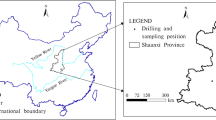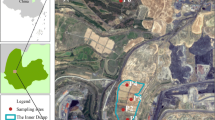Abstract
The pore structure of microbially solidified construction residue soil is an important factor affecting its ability to resist wind erosion and dust. It is challenging to explain the mechanism of microbially induced calcium carbonate precipitation and to more accurately simulate the infiltration process of bacterial liquid given that current studies on pore structure and distribution in this field are restricted to two-dimensional surface observation and macroscopic experimental parameter determination. In this paper, the high-precision image of microbially solidified construction residue soil is obtained by CT scanning, and the three-dimensional network pore structure model of microbially solidified construction residue soil is reconstructed using advanced visualization software (Avizo) and digital image processing technology. Four representative units are extracted from the model in turn, and the maximum ball algorithm is used to statistically analyze the parameters such as pores and throats of the representative units. Results show that the soil’s pore and throat radii are, respectively, distributed around 80 and 60 μm and the fitting indexes are 0.90 and 0.93, respectively. The coordination number is mainly distributed in the range of 4–11, and the fitting index is 0.94. The throat length is distributed in the range of 50–950 μm, and the fitting index is 0.83. According to frequency distributions of pore volume and pore-throat equivalent radius ratio, the pores in the soil are mostly small and micro pores, the pore network is well developed, and the structure is relatively stable. Construction residue soil’s resistance to wind erosion and dust-raising can be significantly improved by microbial solidification. This method can also be useful for nondestructive quantitative characterization of soil meso-pore network structure.














Similar content being viewed by others
Data availability
The data are transparent.
References
Al-Kharusi AS, Blunt MJ (2007) Network extraction from sandstone and carbonate pore space images. J Petrol Sci Eng 56(4):219–231
Bird MB, Butler SL, Hawkes CD, Kotzer T (2014) Numerical modeling of fluid and electrical currents through geometries based on synchrotron X-ray tomographic images of reservoir rocks using Avizo and COMSOL. Comput Geosci UK 73:6–16
Brian B, Robert PE (1998) Percolation theory and network modeling applications in soil physics. Surv Geophys 19(1):23–72
Cheng L, Cord-Ruwisch R (2014) Upscaling effects of soil improvement by microbially induced calcite precipitation by surface percolation. Geomicrobiol J 31(5):396–406
Cheng L, Cord-Ruwisch R, Shahin MA (2013) Cementation of sand soil by microbially induced calcite precipitation at various degrees of saturation. Can Geotech J 50(1):81–90
Cuthbert MO, McMillan LA, Handley-Sidhu S, Riley MS, Tobler DJ, Phoenix VR (2013) A field and modeling study of fractured rock permeability reduction using microbially induced calcite precipitation. Environ Sci Technol 47(23):13637–13643
DeJong JT, Fritzges MB, Nuesselein K (2006) Microbially induced cementation to control sand response to undrained shear. J Geotech Geoenviron 132(11):1381–1392
DeJong JT, Mortensen BM, Martinez BC, Nelson DC (2010) Bio-mediated soil improvement. Ecol Eng 36(2):197–210
Dejong JT, Soga K, Kavazanjian E, Burns S, Van Paassen LA, Al Qabany A, Aydilek A, Bang SS, Burbank M, Caslake LF, Chen CY, Cheng X, Chu J, Ciurli S, Esnault-Filet A, Fauriel S, Hamdan N, Hata T, Inagaki Y, Jefferis S, Kuo M, Laloui L, Larrahondo J, Manning DAC, Martinez B, Montoiz BM, Nelson DC, Palomion A, Renforth P, Santamarina JC, Seagren EA, Tanyu B, Tsesarsky M, Weaver T (2013) Biogeochemical processes and geotechnical applications: progress, opportunities and challenges. Géotechnique 63(4):287–301
Dimitrios T, Lyesse L (2019) A decade of progress and turning points in the understanding of bio-improved soils: a review. Geomech Energy Environ 19:100116
Dong H, Blunt MJ (2009) Pore-network extraction from micro-computerized-tomography images. Phys Rev E Stat Nonlin Soft Matter Phys 80(3 Pt 2):36307
Fan N, Wang J, Deng C, Fan Y, Wang T, Guo X (2020) Quantitative characterization of coal microstructure and visualization seepage of macropores using CT-based 3D reconstruction. J Nat Gas Sci Eng 81:103384
Fatt I (1956) The network model of porous media. Trans AIME 207(01):144–181
Fujita Y, Taylor JL, Wendt LM, Reed DW, Smith RW (2010) Evaluating the potential of native ureolytic microbes to remediate a 90Sr contaminated environment. Environ Sci Technol 44(19):7652–7658
Gomez MG, Anderson CM, Graddy CM, DeJong JT, Nelson DC, Ginn TR (2016) Large-scale comparison of bioaugmentation and biostimulation approaches for biocementation of sands. J Geotechn Geoenviron Eng. https://doi.org/10.1061/(ASCE)GT.1943-5606.0001640
Ivanov V, Chu J (2008) Applications of microorganisms to geotechnical engineering for bioclogging and biocementation of soil in situ. Rev Environ Sci Biotechnol 7(2):139–153
Ivanov AL, Shein EV, Skvortsova EB (2019) Tomography of soil pores: from morphological characteristics to structural-functional assessment of pore space. Eurasian Soil Sci 52(1):50–57
Koestel J, Larsbo M, Jarvis N (2020) Scale and REV analyses for porosity and pore connectivity measures in undisturbed soil. Geoderma 366:114206
Li TC, Shao MA, Jia YH (2016) Application of X-ray tomography to quantify macropore characteristics of loess soil under two perennial plants. Eur J Soil Sci 67(3):266–275
Li X, Lu Y, Zhang X, Fan W, Lu Y, Pan W (2019) Quantification of macropores of Malan loess and the hydraulic significance on slope stability by X-ray computed tomography. Environ Earth Sci 78(16):1–19
Liu L, Shen Y, Liu HL, Chu J (2016) Application of bio-cement in erosion control of leveas. Rock Soil Mech 37(12):3410–3416
Meng H, Gao Y, He J, Qi Y, Hang L (2021a) Microbially induced carbonate precipitation for wind erosion control of desert soil: field-scale tests. Geoderma 383:114723
Meng JQ, Zhang S, Cao ZH, Wang C (2022) Insight on coal molecular-scale pore reconstruction of Tunliu mine and its characterization and analysis. J China Coal Soc 47(s1):160–170
Meyer FD, Bang S, Min S, Stetler LD, Bang SS (2011) Microbiologically-induced soil stabilization: application of Sporosarcina pasteurii for fugitive dust control. In: Geo-frontiers 2011: advances in geotechnical engineering, pp 4002–4011
Mitchell JK, Santamarina JC (2005) Biological considerations in geotechnical engineering. J Geotechn Geoenviron Eng 131(10):1222–1233
Montoya BM, Dejong JT, Boulanger RW (2013) Dynamic response of liquefiable sand improved by microbial-induced calcite precipitation. Géotechnique 63(4):302–312
Naeimi M, Chu J (2017) Comparison of conventional and bio-treated methods as dust suppressants. Environ Sci Pollut Res 24(29):23341–23350
Phillips AJ, Gerlach R, Lauchnor E, Mitchell AC, Cunningham AB, Spangler L (2013) Engineered applications of ureolytic biomineralization: a review. Biofouling (chur, Switzerland) 29(6):715–733
Phillips AJ, Cunningham AB, Gerlach R, Hiebert R, Hwang C, Lomans BP, Westrich J, Mantilla C, Kirksey J, Esposito R, Spangler L (2016) Fracture sealing with microbially-induced calcium carbonate precipitation: a field study. Environ Sci Technol 50(7):4111–4117
Sharma M, Satyam N, Reddy KR (2021) Effect of freeze-thaw cycles on engineering properties of biocemented sand under different treatment conditions. Eng Geol 284:106022
Silin D, Patzek T (2006) Pore space morphology analysis using maximal inscribed spheres. Physica A 371(2):336–360
Tang CS, Yin LY, Jiang NJ, Zhu C, Zeng H, Li H, Shi B (2020) Factors affecting the performance of microbial-induced carbonate precipitation (MICP) treated soil: a review. Environ Earth Sci 79(5):1–23
Terzis D, Laloui L (2018) 3-D micro-architecture and mechanical response of soil cemented via microbial-induced calcite precipitation. Sci Rep. https://doi.org/10.1038/s41598-018-19895-w
Terzis D, Laloui L (2019) Cell-free soil bio-cementation with strength, dilatancy and fabric characterization. Acta Geotech 14(3):639–656
van Paassen LA, Ghose R, van der Linden TJ, van der Star WR, van Loosdrecht MC (2010) Quantifying biomediated ground improvement by ureolysis: large-scale biogrout experiment. J Geotechn Geoenviron Eng 136(12):1721–1728
Whiffin VS (2004) Microbial CaCO3 precipitation for the production of biocement. Murdoch University, Perth
Whiffin VS, van Paassen LA, Harkes MP (2007) Microbial carbonate precipitation as a soil improvement technique. Geomicrobiol J 24(5):417–423
Wu Y, Tahmasebi P, Lin C, Zahid MA, Dong C, Golab AN, Ren L (2019) A comprehensive study on geometric, topological and fractal characterizations of pore systems in low-permeability reservoirs based on SEM, MICP, NMR, and X-ray CT experiments. Mar Petrol Geol 103:12–28
Xie ZY, Zhang W, Yao TF, Wang J, Zhu YC (2020) Quantitative characte rization of spatial pore network of soils based on maximal-balls algorithm. J Eng Geol 28(01):60–68
Xu YB, Qian CX, Lu ZW (2013) Remediation of heavy metal contaminated soils by bacteria biomineralization. Chin J Environ Eng 7(07):2763–2768
Zhan Q, Qian C, Yi H (2016) Microbial-induced mineralization and cementation of fugitive dust and engineering application. Constr Build Mater 121:437–444
Zhang M, Wang R, Liu F, Xu P (2021) Anti-wind erosion and anti-dust mechanisms of microbial consolidation of bare soil. Environ Earth Sci 80(21):1–13
Acknowledgements
This work was supported by the National Natural Science Foundation of China (51580166). Any opinions, findings, and conclusions or recommendations expressed in this material are those of the authors and do not necessarily reflect the views of the National Science Foundation. Thanks to Henan Polytechnic University for providing laboratory equipment and space, Thank you to all the participants and helpers of this work.
Funding
This work was supported by the National Natural Science Foundation of China (51580166).
Author information
Authors and Affiliations
Contributions
The authors of ZM and FC did relevant experiments and wrote the main manuscript text, NS, XP and CC learned and applied relevant software technologies. All authors commented on previous versions of the manuscript. All authors read and approved the final manuscript.
Corresponding author
Ethics declarations
Conflict of interest
The authors have no relevant financial or non-financial interests to disclose.
Additional information
Publisher's Note
Springer Nature remains neutral with regard to jurisdictional claims in published maps and institutional affiliations.
Rights and permissions
Springer Nature or its licensor (e.g. a society or other partner) holds exclusive rights to this article under a publishing agreement with the author(s) or other rightsholder(s); author self-archiving of the accepted manuscript version of this article is solely governed by the terms of such publishing agreement and applicable law.
About this article
Cite this article
Minxia, Z., Congrui, F., Shuangjian, N. et al. Analysis of the pore network structure of microbial solidification of construction residue soil based on CT scanning. Environ Earth Sci 82, 277 (2023). https://doi.org/10.1007/s12665-023-10966-4
Received:
Accepted:
Published:
DOI: https://doi.org/10.1007/s12665-023-10966-4




